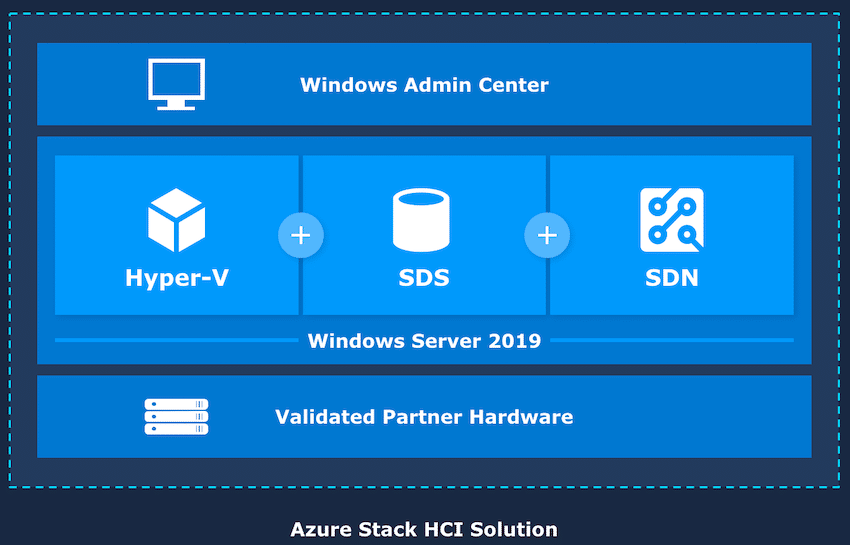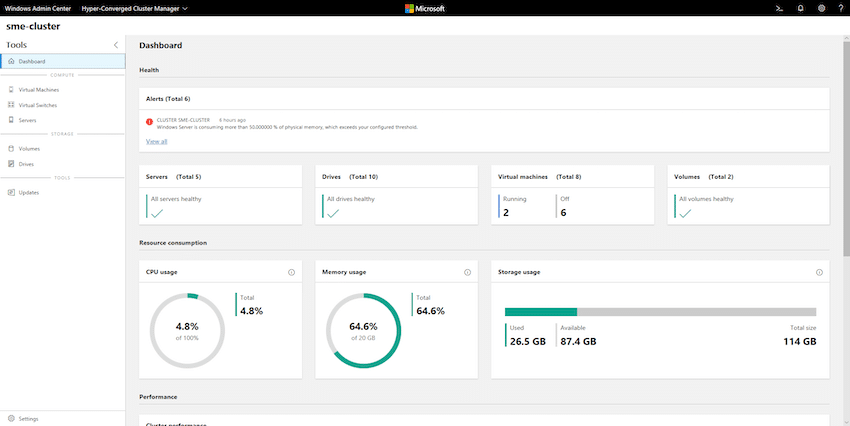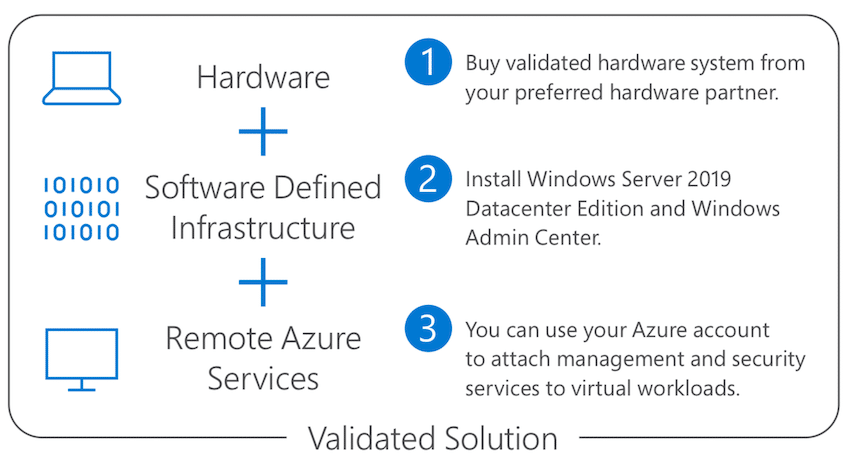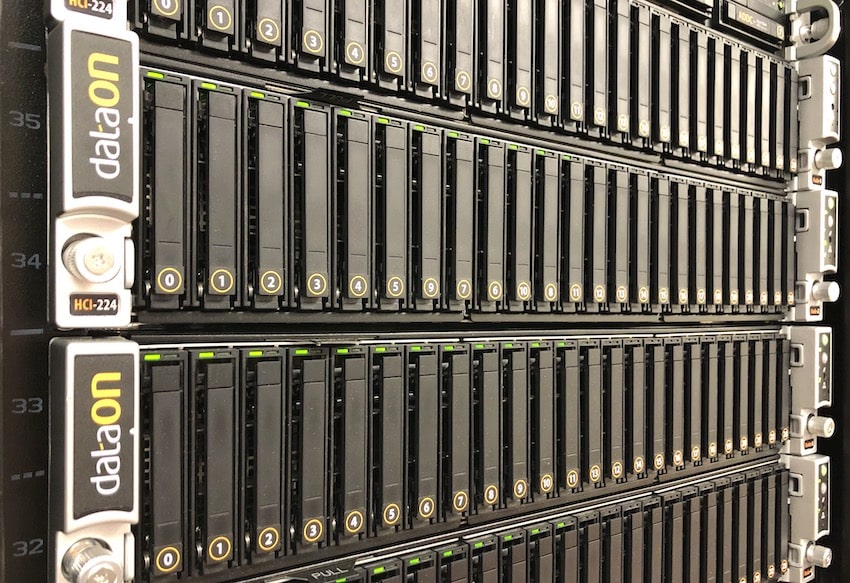
In March of 2019, Microsoft announced Azure Stack HCI, an on-premise implementation of their Azure cloud service. Julia White, Corporate Vice President of Microsoft Azure, in a blog post put it this way, “We are bringing our existing HCI technology into the Azure Stack family for customers to run virtualized applications on-premises with direct access to Azure management services such as backup and disaster recovery.” While both Microsoft Azure Stack HCI and Azure Stack are both on-premise solutions, Azure Stack runs Azure OS with Azure Services, while Azure Stack HCI runs Windows Server OS with Azure Services. Azure Stack is an IaaS and PaaS solution while Azure Stack HCI allows you to efficiently run your virtualized workloads in the manner that you are used to with the added benefit of connecting to Azure cloud for additional services.
What is Microsoft Azure Stack HCI?

Microsoft Azure Deployment Options
This is an interesting play on Microsoft’s part, as not all companies want to or are prohibited (by either corporate governance or government regulation) from running their IT and storing their data on a public cloud such as Azure. Azure Stack HCI presents IT administrators with the same management tools that they use with Azure such as Azure Monitor, Azure Security Center, Azure Update Management, Azure Network Adapter, and Azure Site Recovery. To deliver the HCI components Microsoft uses Hyper-V for its hypervisor and Storage Spaces Direct for its local storage. Azure Stack HCI runs on standard x86 servers, and uses commodity hardware components for its storage and computing, which isn’t always the case in HCI environments.
The Azure Stack HCI announcement from Microsoft gives more insight on how Microsoft thinks about Azure Stack HCI. Microsoft breaks down buying Azure Stack HCI solutions into three different parts: hardware, software defined infrastructure, and Azure services. This blog also points out that Azure Stack HCI solutions are available from partners that offer Microsoft-validated hardware, thereby ensuring performance and the reliability of Azure Stack HCI. By using a Microsoft partner rather than configuring and assembling a system yourself, you can get an Azure Stack HCI environment up and operational without having to spend the time designing, building and testing an Azure Stack HCI solution on your own. Equally as important, you will have a single point of contact for implementation and support services.
Microsoft Azure Stack HCI Components
The major components of the Azure Stack HCI are the hypervisor, the software defined storage (SDS), and the management software. Of these three, most people will be least familiar with Microsoft’s software defined storage solution (SDS), Storage Spaces Direct.
Microsoft Azure Stack HCI Solution
Storage Spaces Direct (S2D) is available in the Datacenter edition of Long-Term Servicing Channel (LTSC) releases of Windows Server, with or without the Desktop experience. The original release was Windows Server 2016, and the most recent is Windows Server 2019. S2D is used to create a hyperconverged infrastructure where storage is shared among and can be accessed from all the nodes in an HCI cluster. S2D accomplishes this by allowing the creation of pools of storage, either block- or file-based, using the local storage resources on each node in the HCI cluster. This storage pool can be easily expanded by adding more nodes to the cluster. The storage provided by S2D can have different resilience and performance characteristics. To deal with the noisy neighbor problem, Microsoft has enabled S2D with a Storage Quality of Service (QoS) feature that ensures that each virtual machine (VM) gets the resources that it needs and prevents the over-consumption of resources from any one VM.
Microsoft has ensured the performance of S2D by making S2D part of the Windows operating system and by using the SMB Direct feature of SMB 3.0, which uses RDMA over iWARP or RoCE with 10/40GbE connectivity between the nodes. To ensure data efficiency and data security, S2D includes advanced storage features such as dedupe and at-rest encryption. S2D can handle large amounts of data as it allows the creation of storage pools with as much as 400TB of raw capacity per server, as much as 4 petabytes of raw capacity per cluster, and allows the creation of up to 64 distinct volumes, each with a maximum size of 64TB.
One of the features of S2D that will be of interest to small businesses and those that use S2D for edge computing is that it can be used in a two-node HCI cluster configuration. Two-node deployments, as you can imagine, require less investment in gear compared to solutions that require three or more nodes. It's also possible to survive two types hardware failures at once, even if one is a complete server failure and the other is a drive failure on the surviving node.
Microsoft has integrated the management of S2D into Windows Admin Center (WAC). WAC is a free on-premises application that is used to manage servers, clusters, hyper-converged infrastructures and Windows 10 computers, as well as S2D. The management of S2D using WAC has been simplified with the use of a dedicated dashboard for the management and monitoring of Storage Spaces Direct volumes.
Windows Admin Center Dashboard
Deploying Microsoft Azure Stack HCI with DataON
DataON has been working with Microsoft for the past decade to provide companies of all sizes with proven Microsoft solutions. DataON was on the forefront and is still one of the leaders in delivering Microsoft Azure Stack HCI platforms. DataON has a proven history of working with the technology that enables Microsoft Azure Stack HCI; they were the first company to have a Windows Server certified platform for Storage Spaces, was one of the first companies to offer Azure Stack HCI nodes, and DataON was the first certified Microsoft partner for Windows Server Software-Defined (WSSD) datacenter for Windows Server 2016. Furthermore, DataON has gone through the process to become one of only seventeen Microsoft certified Azure Stack HCI hardware vendors.
Currently DataON has different nodes to deliver Microsoft Azure Stack HCI. These nodes range from a small 1U node designed for small data centers or remote offices to a 6U node capable of powering a large primary data center. These DataON nodes are powered by second generation Intel Xeon Scalable processors, have Intel NVMe drives, and support Intel Optane persistent memory.
You could hobble together the software and hardware needed to build an Azure Stack HCI solution on your own, but by using a solution provider such as DataON, you avoid the hassle of selecting and assembling the components needed for your solution. Due to DataON’s rich history of working with leading-edge technology and their extensive knowledge in this field, they can guide you to make sure that you end up with the right solution and acquire a turnkey solution based on Azure Stack HCI that will be guaranteed to work and perform as expected.
How to Buy Microsoft Azure Stack HCI Solutions
DataON offers additional features that make it unique among Azure Stack HCI solution providers. Foremost is their ability to support all the components that make up your HCI solution, as DataON supports both the hardware and the software on their Azure Stack HCI nodes. DataON is exclusively focused on Microsoft solutions so if a difficult situation involving software does arise, they have certified Microsoft Azure administrators on staff that have the background and tribal knowledge to deal with it. If a problem requires escalation, DataON has built up a relationship over the years with Microsoft that allows them to pull in the Microsoft resources needed to resolve it. On the hardware side, as DataON specs out the hardware for their nodes, they have intimate knowledge of the components that make up the nodes, and as with Microsoft, have built up a relationship with Intel and their other hardware suppliers in the unlikely event that a hardware issue needs to be escalated.
StorageReview DataON HCI-224 Cluster
We're in the process of putting DataON and Microsoft Azure Stack HCI to the test. DataON recently delivered a four-node HCI cluster to our lab for review, complete with Intel Optane SSDs. The all-NVMe HCI-224 solution is designed for enterprises that want the best performance possible out of their Azure Stack HCI investment. Of course, our focus is largely performance-based, but not every organization needs the fastest solution available. DataON offers a wide variety of more conservative hardware and as a solutions-focused partner, they can help customers source the right Azure HCI cluster, be it two-node hybrid at the edge, or bleeding-edge performance using Optane DC persistent memory and Intel Second Generation Xeon Scalable CPUs in the core.
DataON Azure Stack HCI Solutions





